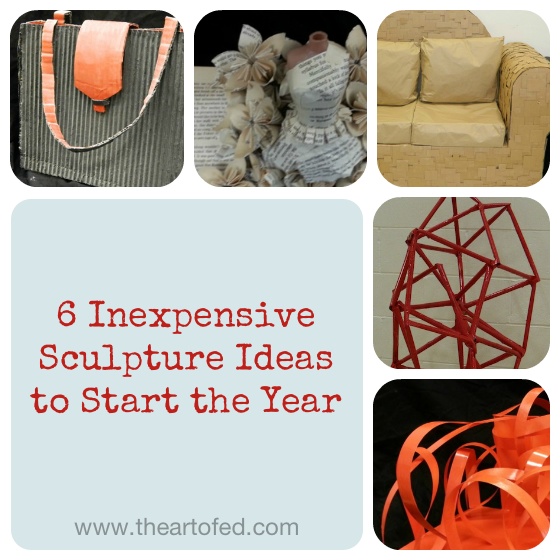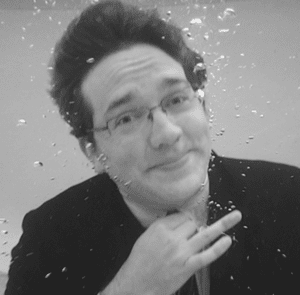In a time where budgets are seemingly always being cut, many of us are looking for ideas that won’t slice into the precious few dollars we have available. So, if you’re waiting on your budget money to come in, or if you don’t have a budget at all, here are six sculpture ideas you can use to create some great projects without spending a lot of money.
Geometric Newspaper Sculpture
Materials Needed: Newspaper, Tape, Spray Paint (optional)
Newspaper is almost always easy to come across, and this lesson is always easy to present. We use rolled up newspaper, taped into small geometric shapes. Those geometric shapes are then combined and stacked to make a sculpture as tall as the person making it. If you’ve got some spray paint lying around, go for it, but these can look just fine au natural. I generally have students focus on a piece that is stable, looks good from all viewpoints, and accentuates the geometric aspects of the sculpture. (Tip: Triangles and pyramids are much more structurally sound than squares, rectangles, or cubes.)
Oaktag Sculpture
Materials Needed: Oaktag or similar material, Glue or Tape, Paint (optional)
You can use oaktag (tagboard), chipboard if you can find it, or even watercolor paper if it is thick enough. We begin with two squares taped or glued together in an ‘L’ shape for the base. Students add strips of different lengths, focusing on creating nonrepresentational sculptures featuring movement. Again, spray paint (or even acrylic) can enhance the look, but the sculpture itself can be successful with or without that addition.
Altered Books
Materials Needed: Old/Discarded Books from your Library or Thrift Store, Scissors/Exacto Knives, Glue
There are a million ways to do altered books, and a myriad of artists from which to draw inspiration. For the project to be truly sculptural, however, the pages need to be used to create three-dimensional forms. Two-dimensional aspects can be utilized, of course, but in this example the pages being formed into flowers are enough once the Barbie is added. If students are having trouble figuring out how to alter pages, a list of prompts and possibilities can be helpful, as can a few extra books with which they can experiment.
Found Object Sculpture
Materials Needed: Anything Your Students Can Get Their Hands On
We start with, well, whatever is around. I show my students work from Bart Vargas–a nationally known artist from my hometown of Omaha–and it gets them up and running with ideas. Between the limitless options with both materials and subject matter, this project can take on so many different shapes and forms. It’s very open-ended, so you could finish with just about anything once your students get their hands on the materials. If your students need some specific direction, animals and insects can be good places to start. We had, for example, a six foot long snake–coiled and ready to strike– made of Mountain Dew cans and hundreds of pieces of plastic silverware “borrowed” from the cafeteria.
Everyday Cardboard Items
Materials Needed: Cardboard, Glue, Paint (optional)
This is a great problem-solving exercise, because kids know what they need to make–and exactly how it should look–if their subject is a familiar object. All they have to figure out is how to get their work to that point using cardboard and glue. Claes Oldenburg is the obvious art history tie-in, and this project is a good challenge when you play with scale like he does. A contemporary artist creating these types of sculptures is Bartek Elsner, and my kids love seeing his work as well. Huge nail clippers, toothbrushes, or cameras can be really cool, as are small scale bikes and cars. If you want to avoid giant projects that take over your room, objects simply done to normal sizes, like the purse seen here, are always successful.
Functional Cardboard Furniture
Materials Needed: Cardboard, Glue or Hot Glue, Packing Tape
This is probably the most difficult of the six projects, and the most time consuming. We spend a lot of time talking about and experimenting with structure. I like to tell the story about my college days and having to build a box out of matboard that someone could stand on, just so students have an idea of the amount of work needed to make these pieces functional. After the strength of the structure is figured out–be it table, chair, couch, or otherwise–exterior treatment and aesthetics concerns are dealt with to finish off the project. If the project is done well enough, you may just have a cardboard couch that’s still in your art room four years after the fact 🙂
With these six projects up your sleeve, you’ll be well on your way to getting your students the 3D experiences they deserve, no matter what your budget looks like.
Tell us, what ideas could you add to the list?
How do you push students with non-traditional materials?
Magazine articles and podcasts are opinions of professional education contributors and do not necessarily represent the position of the Art of Education University (AOEU) or its academic offerings. Contributors use terms in the way they are most often talked about in the scope of their educational experiences.










